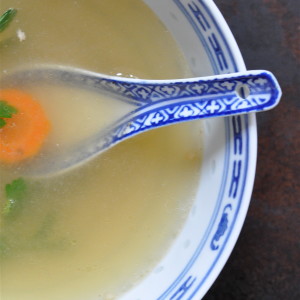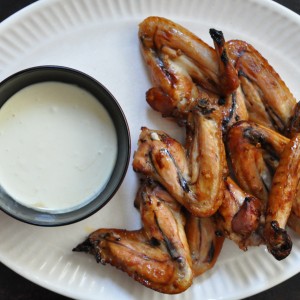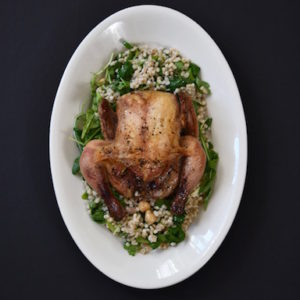Laksa with Chicken and Pumpkin
You would think we only eat pork or poultry around here, and if stats are any indication, some of you are getting bored by this.
Then again, you may be distracted by larger events. Maybe your country is leaving the European Union…or perhaps your country is leaving civilized society entirely. These things have a way of ruining one’s appetite.
—
Moving right along. Laksa. What is it?
Until recently, the IK had no idea herself. James Oseland, editor of Saveur magazine and author of the seminal Cradle Of Flavor, define a laksa thus:
Laksa, or curry noodle soup, is the unofficial national dish of Malaysia. There are countless versions. Some, especially those from the southern part of West Malaysia, use coconut milk as their base…Laksa is a chameleon, radically changing its ingredients and flavors from one town to the next.
Oseland is especially fond of curry mee, a version of laksa made with soft Chinese egg noodles, chicken, tofu, and a spicy coconut milk broth. Right up the IK’s alley.

—
Asian cooking, at least for this non-Asian, is a lot like life: the more time she spends doing it, the less she understands it. Put another way: the IK’s admiration–nay–her adoration–for all things Asian, Southeast or otherwise, just about equals her ignorance. Fortunately, the IK is cognizant of her shortcomings. Which is more than she can say about some people.

So, if you can stand to follow the news (and if you can’t, who could blame you?), you might have noticed California, land of drought, is currently experiencing an “atmospheric river.” This is a fancy term for unbelievable amounts of rain, and then some.

Endless rains and rather chill temperatures do not leave one longing for a bright little salad or a cooling bowl of gazpacho. It’s time for beige stews, root veg, bollito misto, or a nice big bowl of laksa.

This laksa is utterly inauthentic. See above for the litany of mea culpas. The recipe is adapted from Diana Henry’s Chicken and Pumpkin Laksa, found in her endlessly useful A Bird In The Hand. It is a book the IK would likely starve without. She once again suggests you purchase it forthwith, if not sooner.

Though my recipe stretches the definition of “laksa,” it is friendly and adaptable, permitting substitutions of whatever may be lolling about your fridge. In my case, a pumpkin was overstaying its welcome and required cooking.

Other vegetal/protein contenders: winter squash like butternut, delicata, or acorn, sweet potatoes, non-sweet potaotes, carrots, radishes (yes, radishes), mushrooms, green beans, long beans, eggplant, peppers, basil, cilantro, or bean sprouts. Henry’s recipe adds halved cherry tomatoes. Vegetarians could use tofu. Thinly sliced lean pork would probably work, as would any shellfish. Beef isn’t to my taste, but as I say, what do I know?

About Kaffir Lime Leaves: Every food writer notes these critters are difficult to locate. Indeed, it often my experience that the last Kaffir lime leaf has left the building moments before my arrival.

Should you spot a clutch of elusive Kaffir lime leaves, scoop them up. They freeze well.
You’ll notice the lime leaves in this recipe are whole and entire. (Also complete.)This is a mistake. Upon further reading, I learned lime leaves should be finely shredded before being added to a dish. Even in their unshredded state, they infused the laksa with a delicate lime aroma. Still, live and learn.
About cuts of chicken: I made laksa with bone-in, skin-on thighs, my preferred cut when not using a whole bird. Keeping skin and bone on avoids dryness, and we prefer thigh meat. This is the one time I don’t save skin or bone for broth making, as everything is saturated with coconut milk. At the 50-minute mark, the chicken gets boned, skinned, chunked into big pieces, and returned to the pot to finish cooking.

Most of the laksa recipes I’ve read call for buckwheat noodles or fresh Chinese egg noodles. Udon noodles are used here for no better reason than I like their rubbery texture and spongy ability to soak up flavors.
I like udon noodles so very much, in fact, that I’m giving them their own special close-up photo. Trippy, eh?

Heavy rains made photography impossible on laksa-making day: by noon it was dark as midnight. So I put everything away until the next morning, which proved little better, as it continued to pour. This taught me that laksa is best eaten the day it’s made, but does okay a day later. The day after that, California’s drought was officially declared over.

Chicken And Pumpkin Laksa
adapted from Diana Henry’s in A Bird In The Hand
Yield: 3-4 servings, easily scaled upward
Preparation time, based on using bone-in chicken thighs: approximately one hour
1 small pumpkin, halved and seeded
peanut or canola oil
2-3 lemongrass stalks, outer leaves peeled and discarded, soft portions chopped
4 scallions, trimmed, roughly chopped
1 small mild onion, peeled, roughly chopped
or 1-2 small shallots, peeled, roughly chopped
3 stalks of new garlic, cleaned, trimmed, roughly chopped
2-3 garlic cloves, peeled, roughly chopped
1/2 inch piece of fresh ginger, peeled or not, roughly chopped
1-2 fresh green chilis, sliced thinly, seeded or not, according to preference
the juice of one lime
One 13.5 ounce can coconut milk (400ml)
1-2 Kaffir lime leaves, shredded finely or the zest and juice of 1 fresh lime
1 cup (8 ounces) unsalted chicken broth
1 tablespoon fish sauce (nam pla) (see note)
1 1/2 pounds bone-in, skin-on chicken thighs, ideally organic (see notes, and discussion of chicken cuts, above)
about 1pound noodles of your choice; I use Japanese udon noodles sold in 6-ounce packages, and heat 2 packages to feed 2 people. See notes for additional suggestions.
Additional fresh lime juice, to taste
You will need either a food processor, blender, spice grinder, or mortar and pestle for this recipe.
First roast the pumpkin. Preheat the oven to 350F. Halve and seed pumpkin. Place on a foil-lined baking sheet–this makes clean-up easier–and roast, checking for doneness after 30 minutes. A knife should slide through with some resistance. You don’t want pumpkin to be completely cooked through, or it will disintegrate in the laksa. Once the knife goes in meeting gentle resistance, remove from pumpkin oven. Set aside.
If your pumpkin is too hard to halve raw, roast it whole. Puncture it in a few spots to prevent bursting, pour 1/4 cup water over it, and follow roasting directions above. Slice and seed once pumpkin is cool enough to handle. Set aside.
Make the spice paste:
Add the lemongrass, scallion (or whatever allium you’re using), garlic, chilis, and juice of one lime in a food processor, blender, spice grinder, or mortar and pestle. Blend or pound until you have a rough puree. As my food processor blade has been recalled, I used a small processor for this.
If the paste needs to be loosened up, add a little peanut or canola oil.
If you are sensitive to hot pepper and/or wear contact lenses, be careful when handling chili peppers. Wear gloves or wash your hands thoroughly with warm soapy water.
Place a 2-4 quart lidded sandpot or casserole on the stove over low heat. I used a 2 1/2 quart sandpot to make the laksa.
Add about a scant tablepoon peanut or canola oil to the pot. Add the spice paste, increase heat to medium, and stir until the spices start to smell fragrant.
Add the coconut milk, Kaffir lime leaves or additional lime juice, chicken broth, and fish sauce to the pot. Increase the heat to a simmer, but don’t allow the liquid to boil. Stir, then add the chicken.
Reduce the heat to medium; you want a gentle simmer here. Allow the chicken to cook 45-50 minutes, checking the laksa periodically and giving it a stir.
While the laksa simmers, peel and cube the pumpkin, adding it to the pot during the final 20 minutes of cooking.
Cook the noodles according to package directions.
Assuming you have used bone-in thighs, after 45-50 minutes, remove chicken to a plate. It will not be cooked through. Allow it to cool slightly, then remove skin and bones, slicing chicken into pieces. Return to pot and allow to finish cooking, about 10 more minutes.
Taste broth for seasoning; you may wish to add fish sauce, lime juice, or chili pepper. A sprinkling of fresh cilantro is lovely if you have it.
Serve laksa over the noodles with a plate of additional limes and possibly chilis for any heat loving guests.
Laksa is best eaten immediately, but is okay next day. While edible on day three, the noodles become mushy and the flavors are losing vibrancy. Then again, it’s unlikely to last that long.
Notes: Any cut of chicken may be used in laksa, but if you choose boneless, skinless chicken, decrease cooking time accordingly. If using mixed cuts–i.e. legs, thighs, etc, be sure to watch your pot so chicken doesn’t overcook.
Henry’s recipe calls for adding fresh cilantro at the last moment, and the recipe is better for it. Cilantro is highly perishable, so I tend not to keep it around. If you do, by all means use it.
Laksa is endlessly variable: add other hard winter squash like butternut, delicata, or acorn; add sweet potatoes, regular potatoes, red peppers, sprouts, radishes, green beans, eggplants, or tomatoes…the list goes on. Vegetarians can use tofu; shellfish may be added to or replace the chicken. Used thinly sliced pork. And on and on.
If you cannot get lemongrass or kaffir lime, regular limes are fine. If limes prove elusive, lemon juice is okay, too.
About noodles: Chinese egg noodles, soba, dried rice or buckwheat noodles would work here, too. Rice isn’t traditional in laksa–so far as I know–the laksa police won’t come knocking.
A note about Asian fish sauce: everyone sings Red Boat brand’s praises, and they’re right. But Red Boat is not cheap. Viet Huong Brand is excellent, and far less expensive for cooking applications. So I keep both in the fridge, saving Red Boat for use at table.
Had you told me even two years ago that I’d become a woman with two brands of fish sauce in her fridge–let’s not even discuss soy sauces–I’d have laughed at you. Now the joke is on me.





